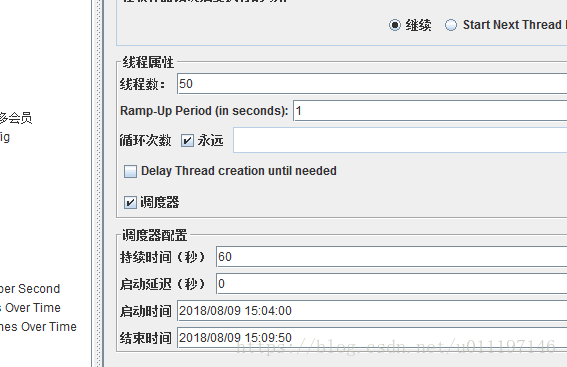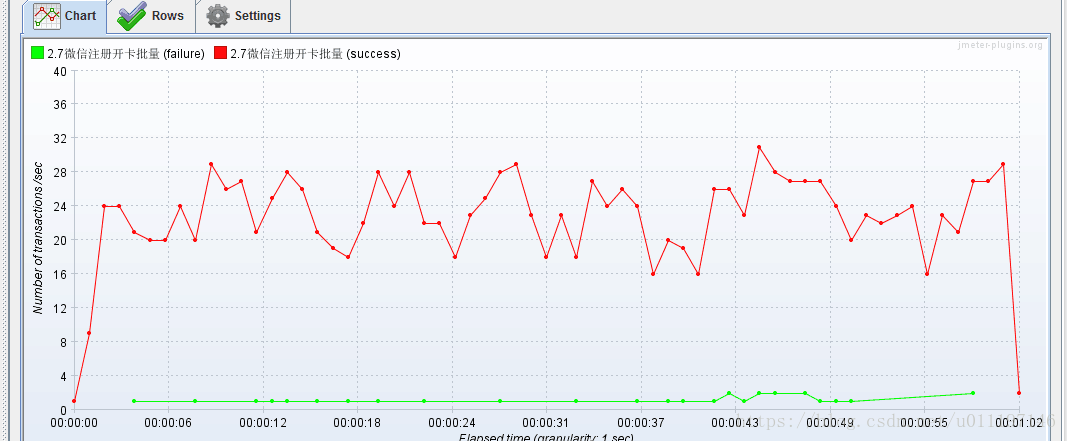1, to obtain TPS plug-in
https://www.cnblogs.com/beginner-boy/p/7806220.html See, saved Baidu cloud disk
2, After the addition, the scheduler remember to use - 50 per concurrent, for 60 seconds, to observe TPS

3, TPS, perform a transaction (including the request, the requesting server, wait for the server to return, and so on, such as a TPS transaction, it may trigger three QPS request)
PS: a second number of transactions processed. TPS The higher the value, the more the number of transactions a second, indicating the faster processing speed, the better the efficiency of the software.
A, TPS: Transactions Per Second (processing of the number of things transmitted per second), i.e., the number of transactions per second server process. TPS includes a message into a message and a plus one user to access the database. (The TPS = CAPS × average per call TPS)
TPS is a unit of measurement software test results. A transaction is the process of a client sends a request to the server and then the server to respond. The client requests the transmission start timing, end timing after receiving the server response, in order to calculate the time of use and the number of transactions completed.
In general, the number of performance evaluation system are completed technology transactions per second to measure. The system as a whole depends on the processing power of the minimum TPS value processing power module.
Two, QPS: QPS queries per second rate is a measure of a particular query server within the specified time how much of the processing flow, on the Internet, as the performance of the domain name system server machine is often used to measure queries per second rate.
Corresponds fetches / sec, i.e., in response to requests per second, that is, the maximum throughput.


Let's learn together the role of these parameters:
(1), Lable: Label: JMeter of each element (e.g. HTTP Request) has a Name attribute, shown here is the value of the Name attribute;
(2), # Samples: this test indicate the total number of requests sent, if simulate 10 users, each 10 iterations, this display 100; [100 I have a user, iteration only once, also 100]
(3), Average: Average response time - by default is the average response time of a single Request, the Controller Transaction when used, may be displayed in units of Transaction Average response time;
(4), Median: median, i.e. 50% of the user response time;
(5), 90% Line ~ 99% Line: 90% ~ 99% of the user response time;
(6), Min: minimum response time;
(7), Maximum: maximum response time;
(8), Error%: error rates occurring in this test, i.e., the number of the total number of errors requests / requests;
(9), Throughput: Throughput - the number of requests completion default representation per second (Request per Second) case, when using the Transaction;
(10), Received KB / src: second from the server side the received data amount;
(1) 1, Sent KB / src: Number per request transmitted from the client.
Sometimes, Throughput Throughput can also represent
4, the number of concurrent throughput
A second interface to be able to withstand a concurrent 50, 50 does not mean that there may be certain;
The system throughput performance is closely related;
Set run time interfaces, such as one second concurrency 50, 60 seconds - the real interface discovery requests 1461, 60 seconds, more stable parameters of the TPS;
Transaction TPS probably about 23, so the current interface, the system can handle about 23
TPS = Request / time
Concept of QPS / TPS / concurrency / system throughput
QPS: number of requests per second is completed; note that this is processed. Specifically it refers to a request to the server successfully processed return results. There will be appreciated that the counter in the server, each of the processing request after adding 1,1 seconds counter = QPS.
TPS: the number of transactions processed per second, the general TPS is in terms of the whole system. How much can an application system 1s transaction is completed, a distributed transaction processing, may correspond to multiple requests for a single interface to measure service processing capabilities, with QPS more.
Concurrency: number of requests that the system can simultaneously process
RT: response time, processing time average processing time required for the request
Calculating a relation:
QPS = concurrency / mean response time
Concurrency = QPS * Average Response Time
5, jmeter limit, up to 100-200 concurrent, try using LR, LR jvm parameters can be monitored
6, Vu and TPS conversion - https://blog.csdn.net/taric_ma/article/details/77285522 article useful
TPS is the number of transactions per second, but the transaction is to rely on virtual users to do it, if a user has completed a virtual pen transaction in 1 second, then the TPS obvious it is 1; if a pen business response time is 1ms, then a users within 1 second to complete the transaction 1000 pen, TPS is a 1000; if a pen business response time is 1s, so a user can only be done in 1 second 1 pen affairs, in order to achieve 1000TPS, users need at least 1000 ; it can be said a user can generate 1000TPS, 1000 users can generate 1000TPS, simply look at how fast response time.
7, performance testing strategy
Performance test cases need to do a set of standardized processes and testing strategies, a number of concurrent users only indicators considered, doing load testing time, generally in accordance with the pressure gradient way to increase the number of users, rather than no estimate of next, a plus tens of thousands of users ,, transaction failure rate is very high, the response time is very long, more than the user within range to endure, this does not mean much, which is like, "how much money can do many things" the same , you need to select the relevant policies.
8, summary
Performance of the system is determined by the TPS, has little to do with the number of concurrent users. In the same TPS, the pressure can go by different users (time set by adding Reflection).
Maximum TPS system is constant (within a range), but not necessarily the number of concurrent users can be adjusted.
Recommended performance testing, do not set too long thinking time to the worst case to put pressure on the server.
In general, large systems (large volume of business machines and more) to do stress tests, 5000 concurrent users is enough, small and medium systems do stress tests, 1000 concurrent users is enough.
Original link: https: //blog.csdn.net/u011197146/article/details/83273879